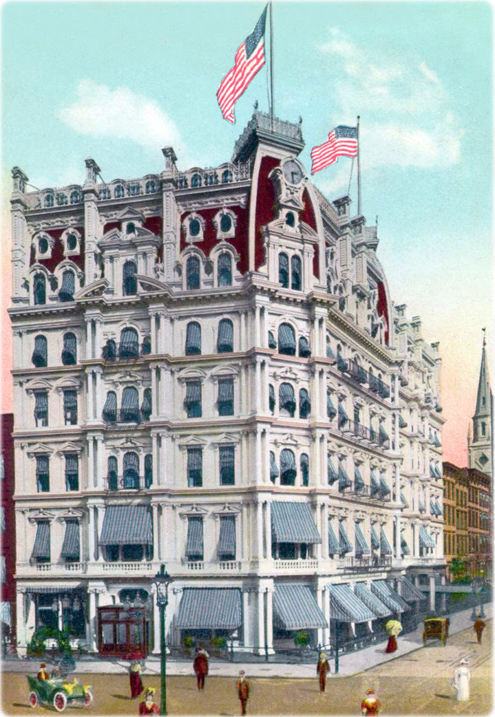
Gilsey House
The Gilsey House, located at 1200 Broadway at West 29th Street, was erected as a high-class 270-room hotel, eight stories high, between 1869 and 1871, in Manhattan. The 125-foot tall building covers 64.5 feet on Broadway and 148.8 feet on Twenty-ninth Street.
This Second Empire landmark was designed by Stephen Decatur Hatch (1839-1894) for Peter Gilsey (1812-1873), a Danish immigrant merchant and city alderman, elected in 1871. Among the buildings erected by him were the Gilsey Building (1854), Gilsey House, the St. George Hotel, the Coleman House and Apollo Hall (located on the corner of Broadway and 28th Street).
The first five stories of the Gilsey House were constructed with a white cast iron façade, which then was topped off by a three-story mansard roof. The cast iron façade and slate roofs were made by the Architectural Iron Works of D.D. Badger & others. The building was constructed to be fire-proof.
Construction began in 1869 on the old site of the Casper Samler homestead. The hotel was formally opened on April 15, 1871. Dr. Henry T. Helmbold's pharmacy with its rich display under the Gilsey House, also opened on the same day. The building was then one of the most imposing among the palace hotels in the City of New York and soon became a popular resort for transient guests and small families. Since August 1871 (maybe since the beginning) the proprietors were Breslin, Gardner & Co (J. Breslin & Brother by 1884).
The rooms were decorated in rosewood and walnut, with veined marble fireplaces, bronze-gilt chandeliers and they were equipped with gas lighting and bath and hot water. It was the first hotel in New York City to offer telephone service. There were communications to the main office by speaking tubes from each room. The hotel was also equipped with steam elevators extending from roof to cellar. See more about its interior design ►
Peter Gilsey died on April 8, 1873. Andrew Gilsey became the owner of the hotel. By 1882, James H. Breslin & Bro. were the proprietors of Gilsey House. By 1884, there were 345 rooms. In the early 1890s there were no stores on the ground floor and the hotel had a few more than 216 rooms. Its restaurant was famous for its excellence. In 1892, Alexander Graham Bell wrote letters to his wife with Gilsey House letterhead paper. Other luminaries such as Oscar Wilde, Samuel Clemens, Oscar Hammerstein and Diamond Jim Brady also stayed at the hotel.
On May 1st, 1900, the new proprietor was Edward O. Roessle and, by the end of the year, the Broadway section, between 14th St. and 42 Str., received asphalt pavement. On March 1st, 1904, the brothers John, Peter and Frederick Gilsey leased the hotel to Albert R. Keen and Lancaster as the Seaboard Hotel Company. They made major improvements to the hotel's decoration. Soon the new lessees realized they could not make it to pay and charged before the court that the Gilseys made false statements as to the earning capacity of the hotel. The Gilsey estate and the hotel operator's Seaboard Hotel Company entered into a lease dispute that reached Supreme Court by June 2, 1904. On December 9, Mr. Keen received a dispossess notice and, in the following day, at 8:30 o'clock in the evening, the hotel closed its doors, after having dismissed its 180 guests in a humiliating situation. On December, 12, the hotel was reopened by order of Henry Gilsey. George H. Moore, chief clerk of the hotel, was announced to be the new manager. In 1907, John Gilsey, one of the owners of the house, died at his home in the Madison Square Apartments.
On December 14, 1908, creditors had a petition in bankruptcy filled against Louis Frank, then the proprietor of Gilsey House. In December 1909, Rube R. Fogel bought the building and, later, he leased it to the Palacio Company. In March 1911, Croton Realty Company bought Gilsey House and ground lease. The hotel was closed in the same year. In 1912, the president of Gilsey House property was Edward S. Napolis. The same year the building was leased to Krower-Tynberg Co., importers and manufacturers of laces and embroideries, and the old building was remodeled (see photo below).
In 1915, Samstag & Hilder Brothers leased the Gilsey House property from Fogel. Later, the external columns in the ground floor were removed. In 1978, the building was added to the National Register of Historic Places and it was designated a New York City landmark in 1979. The old Gilsey House was sold and converted to residential co-op, in 1980, after a modest restoration. The facade was restored in 1992, without the original columns that extended over the building line.

|
Copyright © Geographic Guide - Historic Hotels in NYC. |
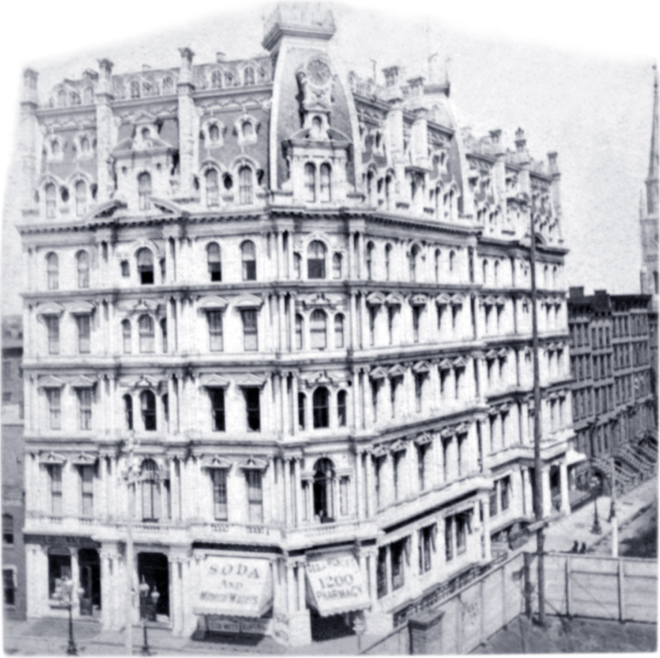
The old Gilsey House in the early 20th century. The West 29th Street is on the right (vintage postcard by American News Company).
Below, the historic Gilsey House on the corner of Broadway and West 29th St. Photo before 1892. There is a pharmacy in the ground floor (America Illustrated - Stereographs of New York City).
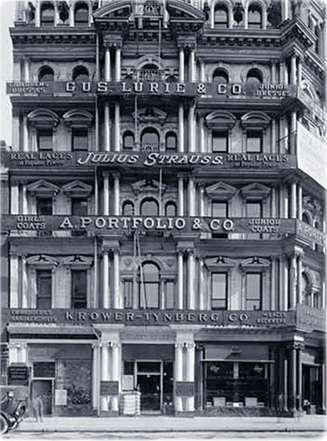
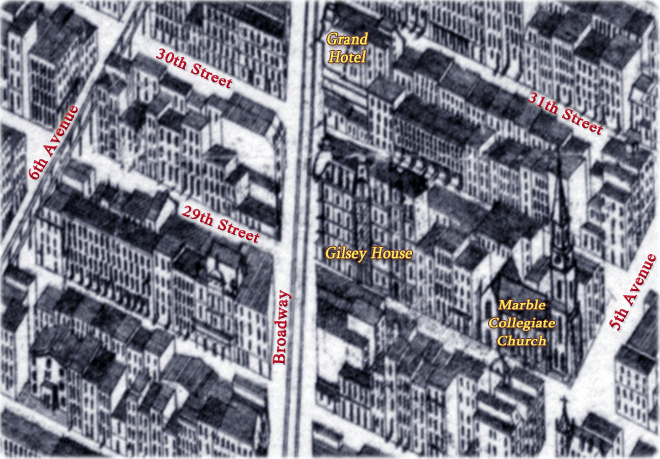
Gilsey House and area around it. Illustration extracted from the plan The City of New York, published by Galt & Hoy, 1879, from the Library of Congress. More: Historical maps of New York City ►
Café Royal, interior view of Gilsey House (vintage postcard, postmark 1908).
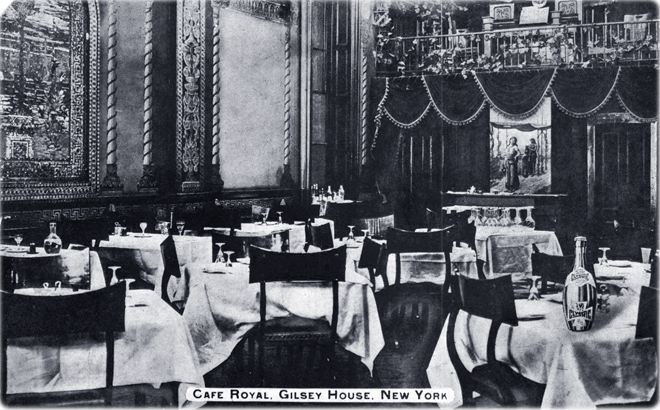
Offices occupied the old Gilsey House about 1914, including the Krower-Tynberg Co. (ground floor) that had leased the building in 1912.
The old Gilsey House about 1979, from the Landmarks Preservation Commission report. It was a decadent commercial building.
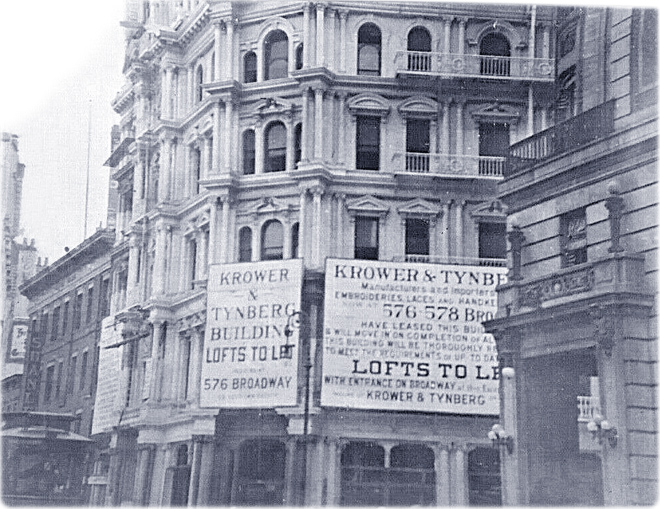
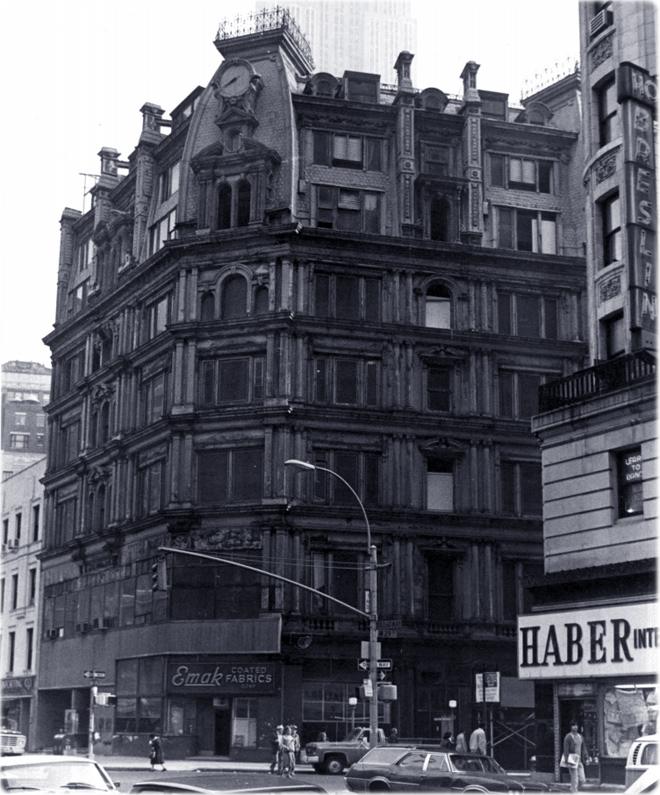
The Gilsey House with signs of lofts to let, around 1912, when the Krower-Tynberg Co., importers and manufacturers of laces and embroideries, leased the building and then the company opened a store in the ground floor. Hotel Breslin is on the right (unknown photographer).

Gilsey House